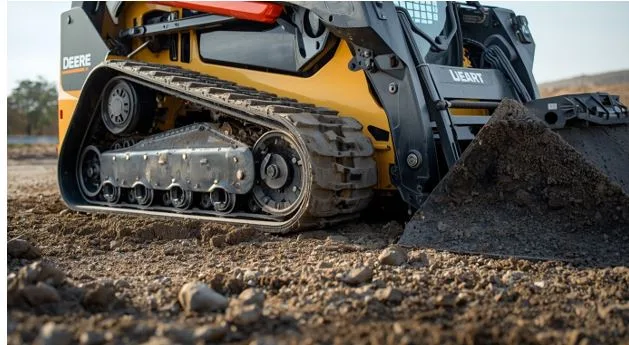How Upgraded Rubber Track Designs Are Changing Daily Work for John Deere Operators
A long workday feels very different when the machine under you moves the way you want it to. There is a quiet kind of confidence that grows after you switch to upgraded tracks and notice how the ground stops fighting back. Many operators talk about this moment as if it were a small turning point. The machine feels steadier. The job feels smoother. And the mind feels lighter knowing the work will not get interrupted by avoidable breakdowns.
This piece explores how new track designs are changing daily work for John Deere operators, what these improvements mean for real job sites, and how the right parts upgrade can take pressure off both the operator and the machine.
Why Track Performance Matters More Than Most Operators Realize
A machine can only perform as well as the tracks allow. Strong engines help, but tracks decide how smoothly the power touches the ground. A small weakness in traction or stability often becomes a big problem during long shifts.
Better Grip Means Better Control
Updated track patterns are designed with deeper tread and cleaner spacing. This helps the machine hold the surface even on sloppy soil or compact dirt. For operators who spend long hours turning, lifting, and backing out of tight spaces, this makes the entire workflow feel less stressful.
Many John Deere operators choose upgraded designs like modern John deere rubber tracks because they keep the machine steady during tasks that need precision. It reduces constant corrections, which saves time and lowers fatigue.
Less Vibration Makes a Noticeable Difference
Vibration is something operators learn to tolerate, not enjoy. New track designs use softer cores and denser outer material to reduce the shaking that travels into the cabin. With fewer vibrations, the operator keeps a better focus on small details, and the machine experiences less wear on internal parts.
Extended Life Saves Time and Money
Stronger rubber blends and reinforced steel cords help new track models last much longer. This means fewer unexpected replacements and fewer interruptions in the work schedule. For busy teams, this is not just a convenience. It is peace of mind.
Real Changes Operators Notice After Upgrading
The biggest compliments upgraded tracks receive rarely sound technical. Operators talk about the feeling of smooth turns, steady lifts, and quieter rides. These experiences have practical meaning because they improve the daily workflow.
Better Balance on Uneven Ground
Landscaping, construction, and agriculture rarely offer perfect soil. Upgraded tracks settle into uneven surfaces without sinking or slipping too quickly. This balance helps operators move faster and work with more confidence.
Cleaner Turns and Fewer Ruts
Old tracks often dig into the ground too aggressively. Updated ones distribute weight more evenly, which helps create cleaner paths and prevents damage to soft sites. This is especially helpful in residential projects where cleanup matters.
Understanding the Tech Behind Modern Track Designs
Upgraded tracks are not just thicker or stronger. They are smarter. Manufacturers study how operators move on different terrains and build the track around those natural patterns.
Key Improvements Found in Today’s Better Tracks
These points capture the most common upgrades that operators search for.
- Heat resistant rubber that reduces cracking during long summer shifts.
- Flexible cores that improve shock absorption.
- Wider lugs that increase ground coverage.
- Self cleaning tread spacing that reduces mud build up.
- Steel cords woven for extra strength during heavy lifts.
- Sidewall protection that lowers the chance of tears.
Each improvement serves a clear purpose. Better control. Longer life. Less stress on the operator and machine.
How These Upgrades Turn Into Real Job Site Advantages
Smoother Movement Means Faster Workflow
When tracks glide instead of drag, operators complete tasks in fewer steps. A job that normally needs five adjustments might only need three. These small time savings build up across an entire day.
Reduced Breakdowns Protects Job Schedules
Downtime affects more than the machine. It affects teams, delivery timelines, and client expectations. Upgraded tracks help prevent the common failures that stop work unexpectedly.
More Comfort Makes Long Shifts Easier
A machine that rides smoothly helps the operator stay focused for longer periods. Good posture, less shaking, and steady traction create a more comfortable environment during long hours.
Signs It Is Time for an Upgrade
Operators often wait too long before replacing their tracks. Small problems show up early and grow slowly.
Watch Out for These Signs
- Tread wearing faster on one side.
- Cracks forming around the edges.
- Track slipping more often.
- Machine feels heavier while turning.
- More vibration entering the cabin.
If these signs show up, the tracks are making the work harder than it should be.
Final Thoughts
Smooth workdays depend on equipment that moves confidently across the ground. Operators who switch to upgraded designs often describe the change not as a luxury but as a relief. Better performance, less shake, more control, and a machine that finally works the way they expect. For anyone looking to get more stability and better traction, updated John Deere rubber tracks help the machine feel steady and predictable.






